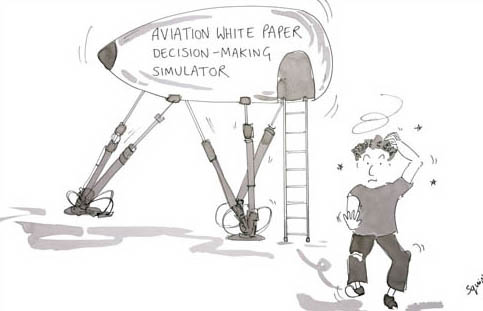5.4 The December 2003 Aviation White Paper
The various studies and consultations produced a mountain of information and opinion, which the DfT had to weave into a single strategy document for the future of UK’s aviation over the next 30 years. The SERAS framework and other studies had little to say on how to balance the interests of various stakeholders from the national to the local and the environmental to the economic. Finding a balance between environmental and economic impacts, and various stakeholder groups, was left to the political process. A team of government ministers, headed by the then Minister for Transport, Alistair Darling, had access to all the information and applied a range of weightings to the various studies and consultation responses. The minutes of the ministerial meetings, including the weightings applied, were still confidential in 2005.
The process outlined so far clearly shows that options had already been limited even before the government officials began drafting the white paper. Decisions had already been made to accept unlimited passenger growth, and that the bulk of this growth should be accommodated within the South East of England. Thus the only major decision to be made at this stage was exactly where to site the expansion: Heathrow, Gatwick, Stansted or a new airport at Cliffe? Even here, it is difficult to identify a clear rationale for the final decision. The final decision contained within the Aviation White Paper was made behind closed doors by government ministers and their advisers.

These were the final recommendations:
There is an urgent need for additional runway capacity in the South East.
The first priority is to make best use of the existing runways, including the remaining capacity at Stansted and Luton.
Provision should be made for two new runways in the South East by 2030.The first new runway should be at Stansted, to be delivered as soon as possible (around 2011 or 2012).
The further development of Heathrow is supported, including a further new runway and additional terminal capacity to be delivered as soon as possible (within the 2015–2020 period) after the new runway at Stansted, but only if stringent environmental limits can be met. An urgent programme of work and consultation will be started to examine this issue further and to consider how best use can be made of the existing airport.
In case the conditions attached to the construction of a third Heathrow runway cannot be met, and since there is a strong case on its own merits for a new wide-spaced runway at Gatwick after 2019, land should be safeguarded for this.
In the Midlands, a new runway will be developed at Birmingham International Airport.
No other proposals put forward during the consultation for new airports at alternative locations are supported.
In summary, the decision making was principally driven by data generated by the DfT reports (e.g. the ‘Air Traffic Forecasts for the United Kingdom’ and ‘Valuing the External Costs of Aviation’ reports) and regional studies (SERAS and the other RAS), and involved a series of national and regional consultations and direct lobbying by a range of stakeholders. The data and decisions made by DfT were contested (and supported) by a vast range of stakeholders during the consultation process, by directly lobbying the government and through the media. It is very difficult to identify the influence of these consultations and pressures on the decision-making process. For example, the final decision does not actually reflect the data proposed by the SERAS study – Heathrow was never considered for development in 2018, and thus there is no cost-benefit data available for this particular decision.
It is clear that at a national level the pro-expansion lobby got exactly what it wanted, while some of the anti-expansion lobby attained minor victories at local level (e.g. no airport at Cliffe). Although potential impacts of airport development at Cliffe were estimated to be the lowest to the local population of all expansion options, development at Cliffe would have affected a nature reserve with a high density of bird species. It is interesting to note here that the Royal Society for the Protection of Birds is by far the most powerful environmental NGO in Europe, with a membership of well over one million, far outstripping any other national environmental NGO.
The Aviation White Paper sets a policy framework for airport development but it did not in itself authorise such development, as discussed in Box 5. Developments on the scale of airport expansion are subject to legislation such as Environmental Impact Assessment. In terms of legislation linked to the Aviation White Paper, a Regulatory Impact Assessment was carried out as part of the same process and was also published in December 2003. Subsequently, the Civil Aviation Bill, introduced to the House of Commons in June 2005, implemented some of the commitments of the 2003 white paper. It set out to clarify and strengthen the measures available to deal with aircraft noise and the powers of airports to set charges reflecting local emissions of pollutants from aircraft.
